Jeff in Iowa
Pair
Great work Gmunny. My unweighted chip also shows Raymond "Pappy" Smith on the other side.
 /
/
@duffman Do all of the chips in that photo of yours have brass flakes?!?
The Mizpah and Vacation Village chips (according to the Chip Guide) are from the 1990s, and would date them to being ASM chips. The $1000 Horseshoe Club is from the 1980s according to the Chip Guide. The $1 Die Swirl/Speed Dice mold chip is from 1969, dating back to Burt Co.
I can't tell if the edge of the $25 Mint Club (TH&C) also has brass flakes, or has something else (dirt or some other metal?) on the edge. If it does have brass flakes, however, that is pretty significant.
Gene Trimble had access to all of the Burt Co. records, and in a 2013 article (http://www.marlowcasinochips.com/links/genetrimble/illegaloftheday/ChristyJones.pdf) he identified the $5 Mint Club chip of that series as the first ever TH&C (Christy Jones) ever produced by Burt, or anyone else. The chips shipped out from the Maine factory in December 1958 to Las Vegas. That would seem to indicate that the first inlaid TH&C chips (assuming that the $5 is same) had brass flakes, but Burt later switched to lead discs in inlaid chips by at least 1962 (according to Dr. Meyer's/Gmunny's data), or that clients had a choice. When Paulson took over in the 1970s they switched over to lead dust. I suppose that some TH&C chips might have been unweighted too.
Great info all. i think also the availability/usage of the brass flakes is color dependent. For example that orange Hotel Nevada doesn't seem to have any flakes.
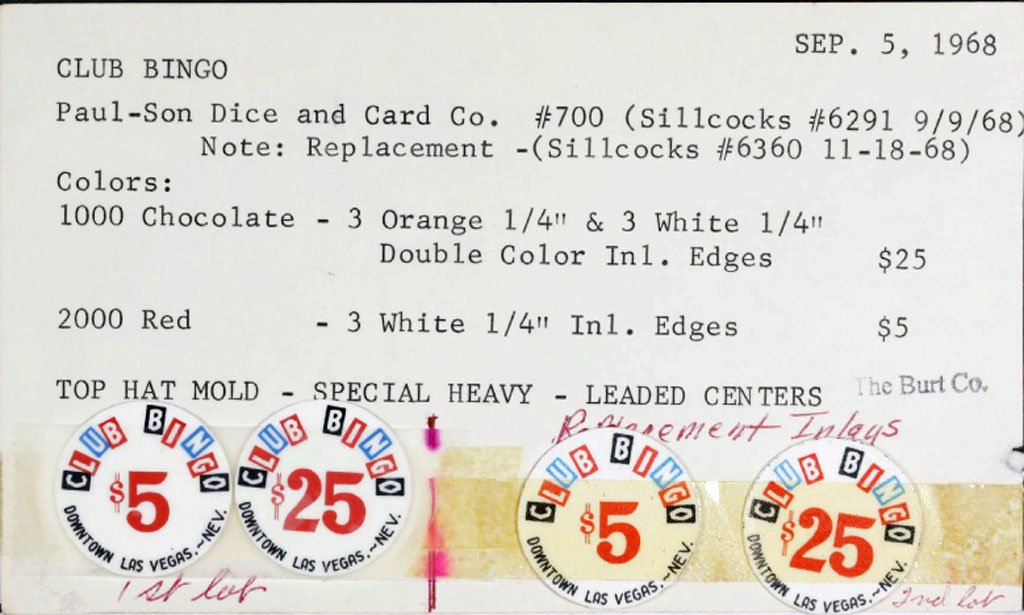
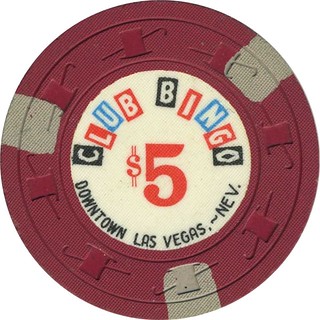
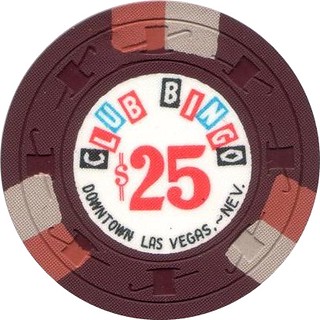
Tungsten is much denser than lead.I just discovered that the Burt Co. did not only use brass powder and lead discs to weight their chips, but they also sometimes used tungsten. Tungsten is an extremely heavy metal, only slightly less dense than lead. You can see it listed in these two Burt order cards for Caessar's Palace chips in 1966 and and 1967. The first order list "Tungsten" and the second order list "Tungsten Wgt. Checks"
View attachment 480711
View attachment 480712
By the way, between 1998 and 2006, Paulson replaced the lead in all of their chips with tungsten. That is what they use now to weight all their chips. It took Paulson 8 years to carry out that transition. If I remember correctly, it was because they had to re-calibrate the dyes and materials in all the colors they produced so that each one would look and weigh about the same as it did with lead. I wonder if the tungsten in those Burt chips made slightly different colors in those Burt chips.
This could also possibly explain why the edge metal flakes in some old Burt chips seem do not appear to be copper/bronze, such as @duffman The Mint Club chips. The Burt order cards for those chips are not posted on the Chip Guide. That discoloration might also just be do to oxidation/tarnishing over time as duffman hypothesized. If anyone has these Caesar's chips, I would be real curious to hear what the edges look like.
Tungsten is much denser than lead.
Tungsten can cost as low as $0.05/gram, especially in an unrefined, flake/powder form which is much more expensive than lead, but nonetheless, you could get some pretty heavy chips for not much more of a price hike, which is why I'm confused as to why Paulsons are much lighter nowadays than the older leaded chips, all it would cost is about 15 cents more, and they could have nice heavyweight chips. For all we know, they might offer a heavier formula, but no casino orders it because there's no reason to, which is also probably what caused the disappearance of shaped inlays. They were an extra cost that the casinos knew wouldn't actually drive anyone to come there, so they just stopped ordering them. That's why you still see them as reorders, but no new casinos or new chips use them, because it's an extra expense, that will only be appreciated by a few people, and definitely isn't a major factor in casino choice for the layman.Tungsten however is more expensive that lead.
Source for this info?between 1998 and 2006, Paulson replaced the lead in all of their chips with tungsten. That is what they use now to weight all their chips. It took Paulson 8 years to carry out that transition.
Has anybody confirmed this?That's why you still see them as reorders
I think Bally's still reorders them, and by reading the earlier posts in this thread I was under the impression the Circus Circus 5 was shaped, so probably yes.Has anybody confirmed this?
The chipguide has been wrong about dates before. But even if they're correct that the circus circus chip was produced 11 years ago, that's hardly confirmation that GPI is still doing it today.I think Bally's still reorders them, and by reading the earlier posts in this thread I was under the impression the Circus Circus 5 was shaped, so probably yes.
As late as 2014 WTHC chips were still being sold in stock at apache, so I'd assume they were still able to make them at that point, and I do think security has something to do with the lack of orders. As far as the boat chips, whoever ordered them may have had the option to get shaped inlays, but again, the prices might be much higher for them, even to a point that it meant they weren't ordered for boat chips. Somebody could always just ask a GPI rep, but they probably won't respond.The chipguide has been wrong about dates before. But even if they're correct that the circus circus chip was produced 11 years ago, that's hardly confirmation that GPI is still doing it today.
If they're willing and able to produce shaped inlays for reorders, why wouldn't they offer it for new orders? Even if only 1 in 100 orders goes for it - if they can sell it for a premium, why not?
Source for this info?
It is my understanding that GPI uses zinc oxide for weight.
I don't think that's a good assumption. Production of those chips stopped long before 2014.As late as 2014 WTHC chips were still being sold in stock at apache, so I'd assume they were still able to make them at that point
I have no clue what they use for weight personally, but it seems kind of foolish to use zinc oxide, as zinc oxide is about half as dense as lead, there are a lot of other options, that would weigh closer to the weight of lead. Of course, I don't know much about their manufacturing process and requirements, but still.It is my understanding that GPI uses zinc oxide for weight.
Yep, both of my chips are near-identical, except for the inlay artwork. Both are excellent condition (the newer one actually appears to be mint), both are SCV mold, both have crosshatching on the shaped inlay surface, both 'feel' the same, and both appear to weigh roughly the same -- 9.0 to 9.2 grams, estimated given my scale's limitations.
(My scale only reads full grams -- both chips display 9g independently, both chips together = 18g, and each chip with another known 8g object always displays 17g. That would indicate that they do not weigh less than 9.0, nor weigh more than 9.25. Yes, it's possible that one could actually weigh 8.6 and the other 9.4, but they feel much closer than that).
It is also very possible that my 1991 version chip was not actually produced in 1991, but was a subsequent re-order -- possibly even after 1999, but prior to the 2009 inlay changes. That would explain the similarities in weight, since they would both have been made with the new lead-free formula. Of course, the chip guide might be mistaken, with the 2009 chip actually having been made in 1999.
We need to find a really worn 1991 version (more likely to be original issue) and see how heavy it is.
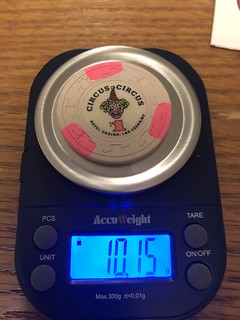
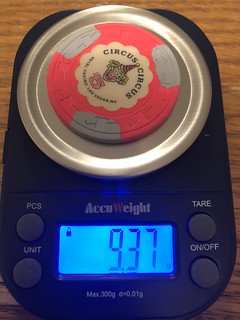
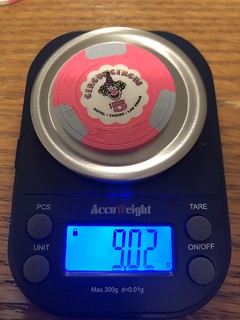
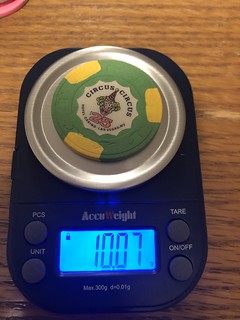
i was not in charge of the operationDid you ask? If so what was the answer and price difference?

